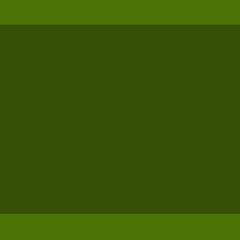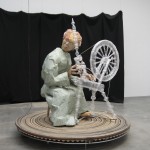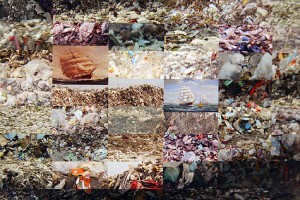
The Rapture, by Mark Shetabi, and sculpture of a gas station with a peephole beneath into a bunker. As Roberta said, it was one of four things in the show that had sold signs on them.
Saturday was rainy, but I managed to see a few of the things I wanted to see. I’m going to add a comment or two on some things Roberta saw and then add a couple of things she didn’t see.
My first stop was Philly artist Mark Shetabi’s work at Jeff Bailey Gallery was Mark Shetabi’s work, mostly paintings of grisaille empty, oppressive spaces filled with longing–longing for contact, for understanding, for a place on this planet to call one’s own (Roberta’s post here). I especially enjoyed Sculpture, a painting of a gas station, one of Shetabi’s repeating subjects–the other gas station in this exhibit is the actual sculpture itself–The Rapture.
Of course a gas station is a fine symbol of our relationship with Iran and the entire Middle East. It’s not a place for comfort, but it’s an icon for materialism and power. That such a homely place, a sort of hell on earth, can be the sought-after Holy Grail is astonishing.
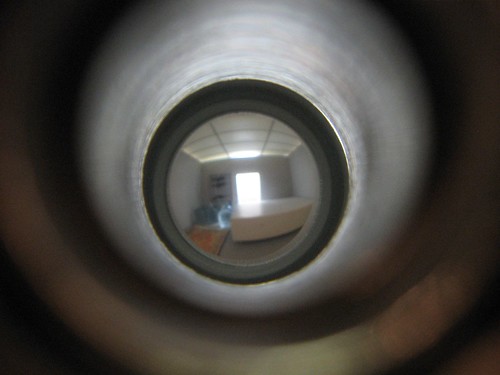
Shetabi, detail of the bunker behind the peephole in The Rapture, with bottles of water as well as sunlight streaming in and an Oriental rug on the floor.
In the Rapture, Shetabi also adds bunker-like toilets and office behind the fueling area, and beneath, another bunker behind a peephole. This bunker has bottles of water as well as a bed. There’s liquid gold and liquid gold. There’s real survival and economic survival.
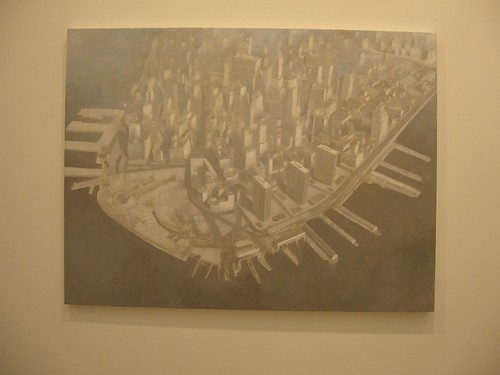
Mark Shetabi, The Ambassadors – New York, is one of a matched pair of paintings, the other being of Isfahan. This one is based on an architectural model by Mies van der Rohe, which means it dates to a time before the World Trade Center. In front of Shetabi’s paintings, I can’t help but think these sorts of things.
And speaking of liquid gold and the clash of cultures, Andreas Gursky, who invariably sets me thinking, also knocked me out with his cultural observations–some of them also related to our culture’s dependence on oil and to the Middle East.
The pair of Pit Stop images fill a whole wall at Matthew Marks. Their Raft of the Medusa drama seems like a waste of energy to those of us who don’t spend our lives watching Nascar.

Andreas Gursky, Bahrain, the new Formula 1 racetrack there.
Especially bizarre to me was the Formula 1 racetrack in Bahrain, an image I had seen before on line. In person, the scale was a reminder of the endless desert and the strange way our Western version of car racing has penetrated the Arab culture. At this moment in time in this country, we seem to be in a war of ideology with Muslim cultures, but, clearly, at the Bahrain racetrack, there is no war at all. We apparently already won. I also don’t really know how doctored that image is of the track, which according to online maps, does look rather strange, but not nearly as strange as Gursky’s image.
The relationship between Shetabi’s unpeopled spaces, and this image of Gursky’s was a highlight for me, with the two artists talking to each other in my head.
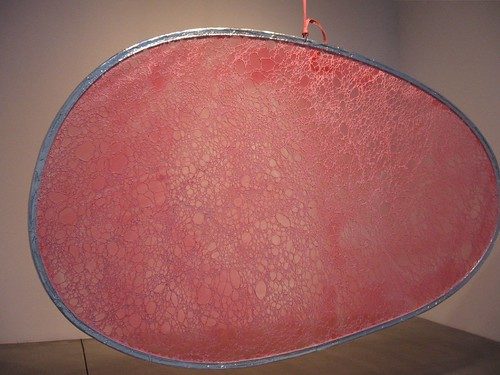
Tim Hawkinson, although his materials and methods are all over the place, invariably manages to touch on how vulnerable and weird is the mechanical body that supports our brains. How he gets the disgusting in at the same time that he points out the magic is quite wonderful! You can get to Roberta’s post on Hawkinson here. Mostly I’m just looking for an excuse to put up still another picture of his work, which was at PaceWildenstein.
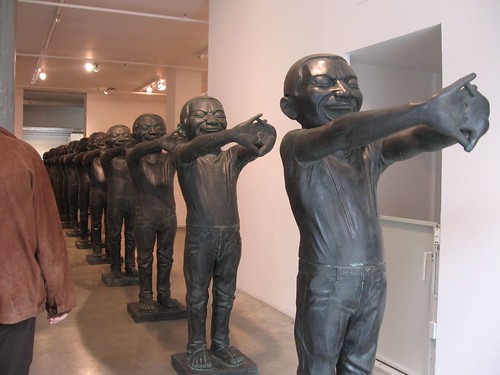
Yue Min Jun, 25 Contemporary Terra Cotta Warriors
At Max Protetch, Yue Min Jun’s 25 Contemporary Terra Cotta Warriors was an obvious reference to the ancient terra cotta army, even without the title. However the terra cotta army were individuals. Yue’s warriors are clones, with manic grins and t-shirted, rather sexless bodies. All in all, the ancient warriors are the more human.

Tobias Putrih, Studio @ Max Protetch
Also at Protetch was an environment made of modular, interlocking plywood parts with the blond Ikea finish we’ve all come to expect in our furniture. The work was by Tobias Putrih, who will representing Slovenia in the 52nd Venice Biennale (he lives and works in New York, now). I liked walking into the jungle with its anti-utilitarian impracticality. It may look like Ikea, but it’s a rebellion against the formula. It also has room for interactivity, the shapes being the sort you can build with like a Tinkertoy–no need to follow those miserable Ikea instructions. Too often have I followed them and found myself needing to start over.
The interlocking shapes reminded me of the desktops that Kent Latimer made into figures. But Latimer is about reusing found materials to create something new–and handmade and quirky. Putrih seems to be about the end of quirkiness, the standardization of mass production. It was a nice pairing with the cloned terra cotta army in the gallery’s main space.



